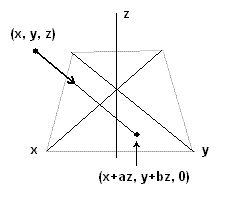Oblique projection
Oblique projection is a simple type of graphical projection used for producing pictorial, two-dimensional images of three-dimensional objects.
What it is
Oblique projection is a type of parallel projection. Thus, it projects an image by intersecting parallel rays (projectors) from the three-dimensional source object with the drawing surface (projection plane). In both oblique projection and orthographic projection (the other type of parallel projection), parallel lines of the source object produce parallel lines in the projected image. The projectors in oblique projection intersect the projection plane at an oblique angle to produce the projected image, as opposed to the perpendicular angle used in orthographic projection.
Mathematically, the parallel projection of the point on the -plane gives . When , the projection is orthographic. Otherwise, it is oblique.
Oblique pictorial
In an oblique pictorial drawing, the angles displayed among the axes, as well as the foreshortening factors (scale) are arbitrary. The resulting distortions make the technique unsuitable for formal, working drawings. Nevertheless, the distortions are partially overcome by aligning one plane of the image parallel to the plane of projection. Doing so creates a true shape (isometric) image of the chosen plane. Cabinet Projection, popular in furniture illustrations, is an example of such a technique, wherein the receding axis is scale to half-size and drawn at an angle of 45-degrees.





